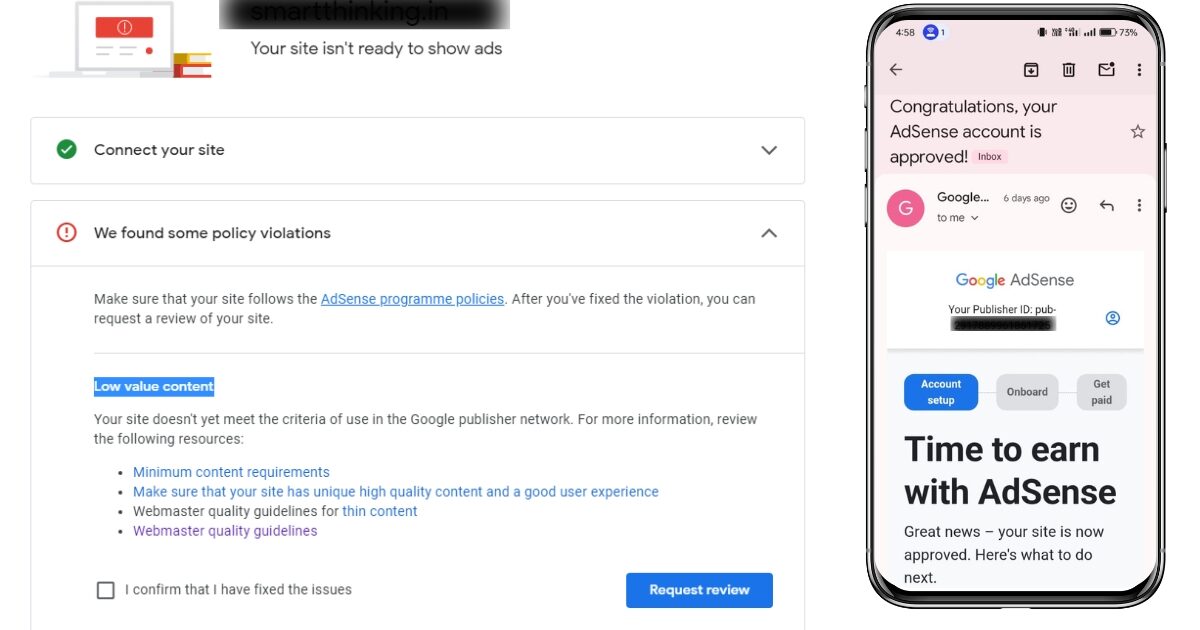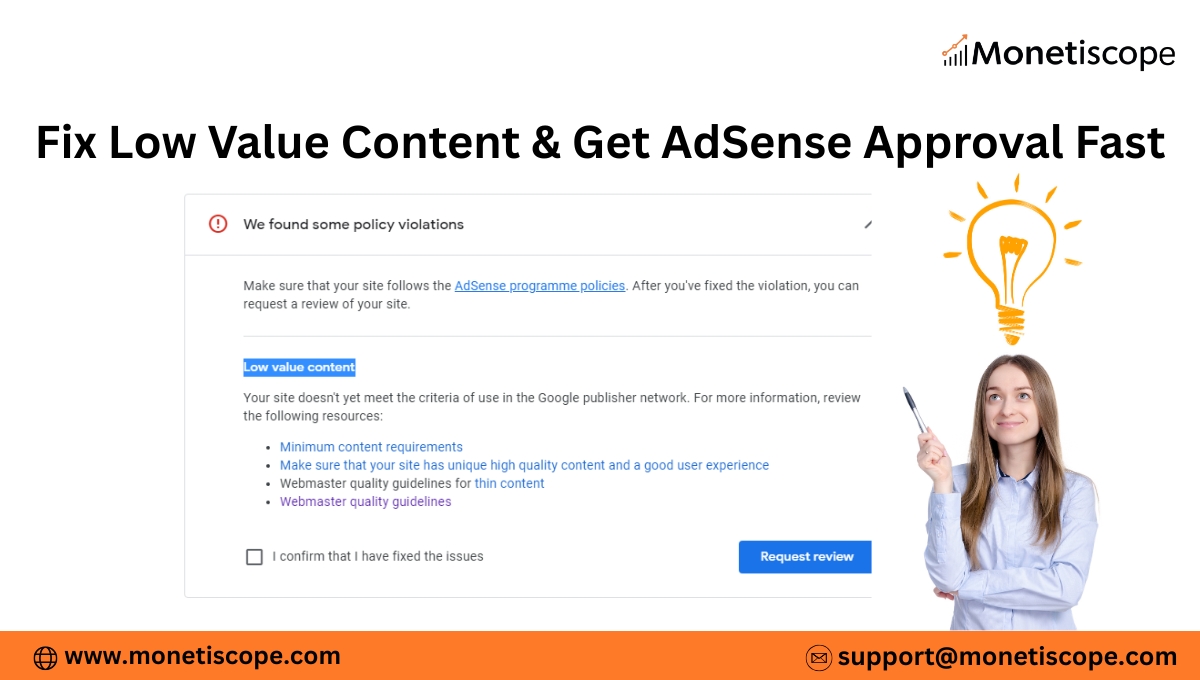Getting Google AdSense approval is one of the biggest milestones for bloggers and website owners. However, many beginners face rejection because of two common reasons: low value content and minimum content violations.
If you received an AdSense rejection email highlighting these issues, don’t panic. You can fix them with the right approach. This article will explain why this happens, how you can solve it, and how to build a strong foundation for AdSense approval.
What Does “Low Value and Minimum Content” Mean in AdSense?
Before fixing the problem, you need to understand what it actually means.
- Low Value Content: Google thinks your website does not provide enough value to readers. Your content may be too short, repetitive, or copied from other sources.
- Minimum Content Violation: Your website does not have enough original articles or pages to be approved. Google wants to see depth, quality, and uniqueness.
So, fixing this issue requires creating useful, original, and well-structured content that engages users.
How to Fix Low Value and Minimum Content Violation for AdSense Approval
Below are the most effective ways to fix this issue. Each step will guide you toward building a quality website that meets AdSense standards.

1. Write High-Quality, Original, and In-Depth Articles
The first step is always content quality. AdSense approval depends heavily on how useful your website is for readers.
- Avoid copy-paste from other sites. Google can detect duplicate content instantly.
- Write at least 1,000 to 1,500 words per article. Longer articles cover topics in more detail.
- Use simple, clear, and easy-to-read language.
For example, if your blog is about “mobile reviews”, don’t just write features. Add comparisons, pros and cons, and user experiences. This will make your article more valuable.
2. Apply Only When Your Traffic Starts Coming
Many beginners apply for AdSense immediately after creating a website. That’s a big mistake.
- AdSense doesn’t require huge traffic, but your website should have at least consistent daily visitors.
- A blog with zero or very low traffic looks inactive, which reduces approval chances.
- Try to get at least 50–100 daily organic visitors before applying.
Traffic shows Google that users actually find your content valuable.
3. Add Google Search Console
Google Search Console is a free tool that helps Google understand your website better.
- Submit your sitemap to make sure Google indexes all your pages.
- Track which keywords your articles are ranking for.
- Fix errors like broken links, missing pages, or crawling issues.
When your site is properly indexed, AdSense can review your content more easily.
4. Connect Google Analytics
Google Analytics is another free tool that every website owner should use.
- It shows traffic sources, user behavior, and engagement levels.
- Helps you identify which content performs best.
- AdSense also checks if your website has real, organic traffic and Analytics supports this credibility.
Linking Analytics makes your site look more professional.
5. Implement ads.txt File
An ads.txt file tells advertisers that you are the authorized publisher of your website.
- Create a simple
ads.txtfile and upload it to your site’s root directory. - Add your publisher ID once AdSense provides it.
- This step builds trust and prevents fake advertisers from misusing your site.
Google itself recommends ads.txt for better transparency and security.
6. Maintain Proper Website Structure
Google checks how well your website is organized. A messy layout creates a poor user experience.
- Use categories and menus. Don’t leave your homepage blank.
- Make sure your site has important pages like About Us, Contact Us, Privacy Policy, Disclaimer, and Terms & Conditions.
- Avoid broken links and empty categories.
A structured website looks professional and increases your chances of approval.
7. Add a Minimum Number of Quality Posts
Quantity also matters along with quality. Having too few posts will trigger minimum content violations.
- Aim for at least 20–25 high-quality blog posts before applying.
- Don’t publish thin articles like 200–300 words. Focus on detailed, useful content.
- Cover different topics within your niche. This shows Google your website has depth.
For example, if you run a fitness blog, publish articles on workout plans, nutrition tips, supplements, and lifestyle habits.
8. Improve Content Formatting and Readability
Good formatting makes your content more engaging. Google considers user experience as a ranking factor.
- Use H2 and H3 headings to break your content.
- Write short paragraphs (2–3 lines each).
- Use bullet points and numbering to make articles scannable.
- Add images, infographics, or videos to improve presentation.
A neat and well-formatted blog is easier for both users and Google bots to understand.
9. Avoid Auto-Generated or AI-Spun Content
Google’s policies clearly mention that low-quality auto-generated content will be rejected.
- Avoid tools that spin content or rewrite articles from other sources.
- Even if you use AI tools, make sure you edit and add your own expertise.
- Add personal experiences, case studies, and examples to make your content stand out.
Original content shows credibility and builds trust.
10. Focus on Niche-Specific Topics
Many websites fail because they publish random articles without a clear direction.
- Pick a niche like tech, travel, finance, health, education, or lifestyle.
- Stick to that niche and cover different subtopics under it.
- Avoid mixing unrelated posts like “fashion tips” and “car reviews” on the same site.
A niche-focused website helps AdSense understand your audience and approve faster.
11. Improve Your Website Design and User Experience
AdSense checks your site’s design to ensure it provides a good experience.
- Use a clean, mobile-friendly theme.
- Avoid too many pop-ups and unnecessary widgets.
- Make sure your website loads fast. Slow websites frustrate users and reduce approval chances.
- Keep navigation simple and clear.
Remember: A professional-looking website always creates a good impression.
12. Avoid Copyrighted Content and Images
One major reason for low-value content rejection is the use of copyrighted material.
- Don’t copy images from Google search. Use free stock image websites like Pixabay, Pexels, or Unsplash.
- Don’t publish pirated movies, songs, or software.
- Write content in your own words instead of copying from other sites.
Google is strict about copyright violations, so avoid them completely.
13. Build Essential Pages Before Applying
Every professional website needs some important pages. These pages also help AdSense check authenticity.
- About Us: Explain who you are and what your website offers.
- Contact Us: Add a form or email address so users can reach you.
- Privacy Policy: Mention how you collect and use data.
- Disclaimer: Protects you legally in case of content issues.
- Terms & Conditions: Defines user rules and site limitations.
Without these pages, your site looks incomplete.
14. Make Sure Your Content Is Indexed in Google
If Google can’t find your content, it can’t review your site properly.
- Add your website to Google Search Console.
- Submit your sitemap for indexing.
- Check if your articles appear in Google search using
site:yourdomain.com.
Unindexed content can lead to rejection.
15. Focus on SEO Best Practices
Search Engine Optimization (SEO) plays a huge role in building authority.
- Use relevant keywords in titles, headings, and content.
- Avoid keyword stuffing.
- Add internal links between related posts.
- Optimize meta descriptions and image alt text.
SEO not only improves traffic but also increases AdSense approval chances.
16. Ensure Website Safety and Compliance
AdSense only approves safe and trustworthy websites.
- Install an SSL certificate (HTTPS).
- Avoid adult, gambling, or illegal content.
- Ensure your website doesn’t redirect users unnecessarily.
- Keep your site free from malware and spam.
A safe website builds trust with both users and AdSense.
17. Give Time Before Reapplying
Many beginners make the mistake of reapplying too quickly.
- Wait at least 15–20 days before applying again.
- Use this time to fix content quality and site design.
- Publish more fresh articles regularly.
Patience increases your chance of approval.
Frequently Asked Questions (FAQs)
1. What is the main reason for low-value content rejection in AdSense?
It usually happens when your website has thin, duplicate, or auto-generated articles that don’t provide value to readers.
2. How many blog posts should I have before applying for AdSense?
Ideally, you should publish at least 20–25 high-quality posts of 1000+ words each.
3. Can I use AI tools to write articles for AdSense approval?
Yes, but you must edit them carefully, add originality, and ensure they follow Google’s quality guidelines.
4. Does website design affect AdSense approval?
Yes, a clean, user-friendly, and mobile-responsive design increases your chances of approval.
5. Can I get AdSense approval with copied images?
No, using copyrighted images can get your site rejected. Use royalty-free stock images instead.
6. How long should I wait after rejection to reapply for AdSense?
You should wait at least 2–3 weeks and fix all issues before reapplying.
7. Do I need traffic before applying for AdSense?
Yes, you should apply only after your website starts getting consistent organic traffic.
8. What is ads.txt and why is it important for AdSense?
Ads.txt is a file that proves you are an authorized publisher. It increases transparency and prevents ad fraud.


